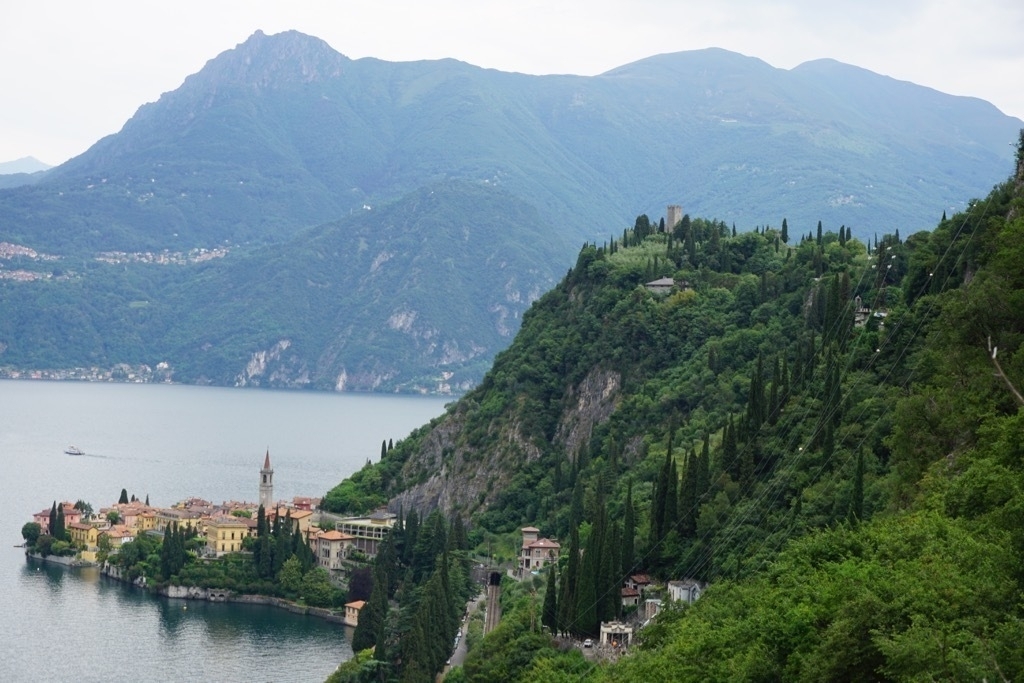Category: Longform
You are viewing all posts from this category, beginning with the most recent.
Summary of Azamara Cruise
Summary of Azamara Cruise
For future reference I like to record the itinerary and favorite stops from a cruise. So here goes.
Azamara Journey June 12 - 23, 2015
- Venice, Italy
- Dubrovnik, Croatia
- At sea
- Crete, Greece
- Santorini -- hike Fira to Oia
- Mykonos -- morning trip to Delos
- Patmos
- Kusadasi (Ephesus) Turkey
- Lemnos (replaced Lesvos due to unrest)
- Istanbul, Turkey
Its hard to say what my favorite stop was on this trip. I enjoyed seeing the old city of Dubrovnik and hiking around the walls. I enjoyed our hike from Fira to Oia on Santorini (despite the fact that it was hot and I complained about the heat) I enjoyed our scooter rental explorations on Patmos. I enjoyed our tour, rug bargaining, and the evening concert in Ephesus, I enjoyed our cooking class in Istanbul.
Minus the screwup on our suite, the Azamara experience was really nice and relaxing. We enjoyed the fact that drinks were included, and so we didn’t have pocketsful of paper for signing for anything and everything. We enjoyed our freedom to dine in the specialty restaurants (Prime-C and Aqualina) whenever we wanted, and we had a great time at the best-of-the-best night with the other suite guests. The formal table service was a show unto itself, with all of our butlers serving us in synchrony like the servants at Downton Abbey.
Cooking in Istanbul
Cooking in Istanbul
Since we had done all the usual tourist things during our previous visit to Istanbul we decided to try another popular thing to do this time around. A cooking class. Other than the kebabs we enjoyed during our previous visit we really didn’t get to learn that much about Turkish cuisine so we decided to sign up for a cooking class with Cookistan
We took an (overpriced) cab from the docks up to the Radisson Plaza where we met our instructor for the day along with a bunch of (much younger) cooking enthusiasts. Our instructor, AyŠın, was phenomenal. She had a great sense of humor, and great timing in everything we did that day. We started out with a walking tour of her neighborhood to get a sense for the kinds of small shops that people use today in modern Istanbul. When we arrived at the cooking school this was all set up for us.
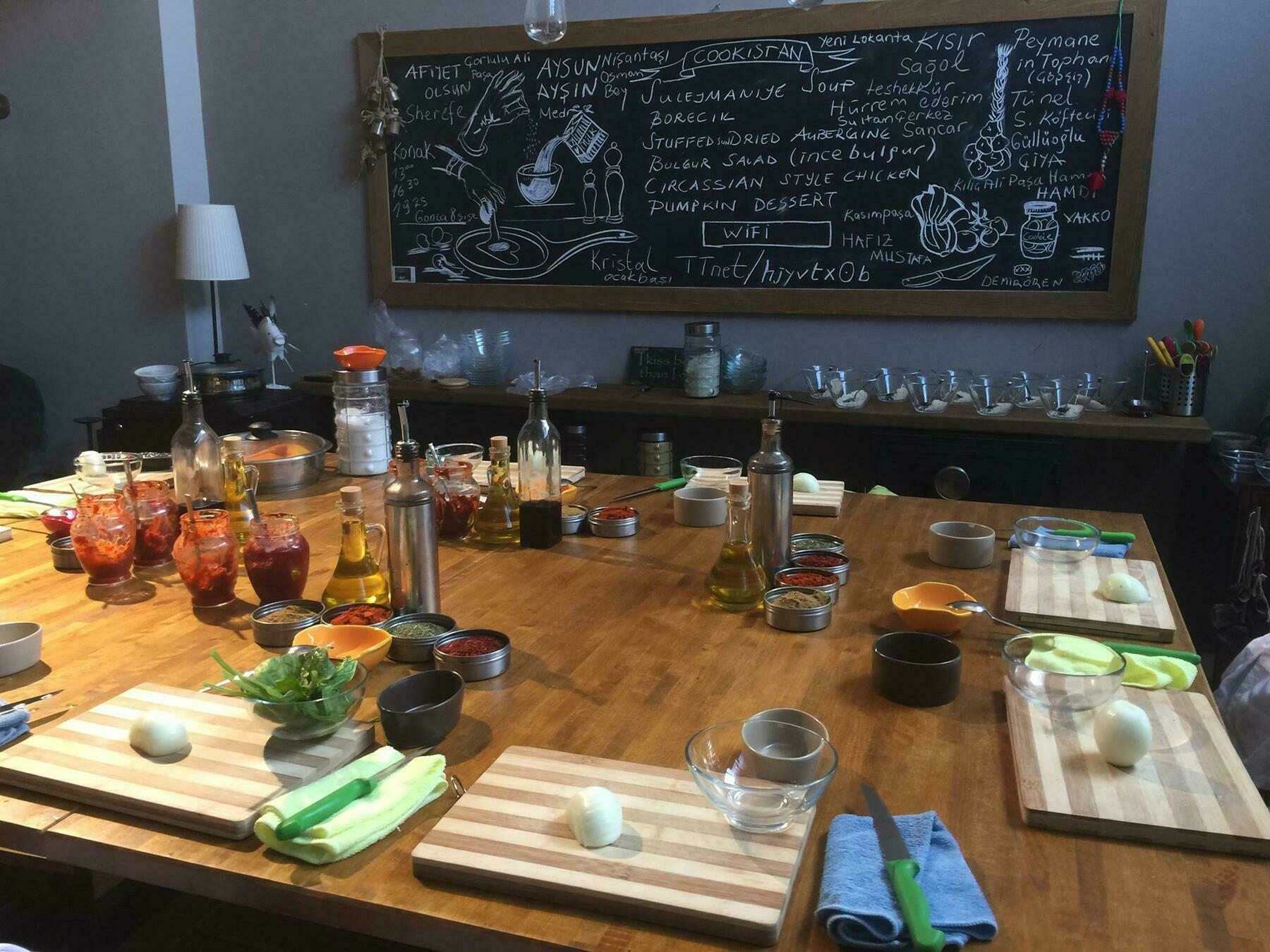
The menu for the day can be seen on the chalk board:
- Suliman Soup -- Yes, I now officially like lentil soup.
- Borecik -- a delicous meat mixture baked in pastry
- Stuffed dried Aubergine -- even though aubergine sounds a lot better than eggplant, I’m still not a huge fan. Although they were not too bad. We also used the same mixture to stuff grape leaves and I really liked that.
- Bulgur Salad -- Again, a new salad, and I’m fan.
- Circassian Style Chicken. Kind of a cold chicken salad that you can eat with a spoon or put on bread for a sandwich.
- Pumpkin Dessert -- Maybe the only thing all day I really didn’t appreciate. -- It was too much like eating sweet squash for my palete
In a very small world moment you can see the young man in this picture with me, who works on the same team at Epic with one of my former students!
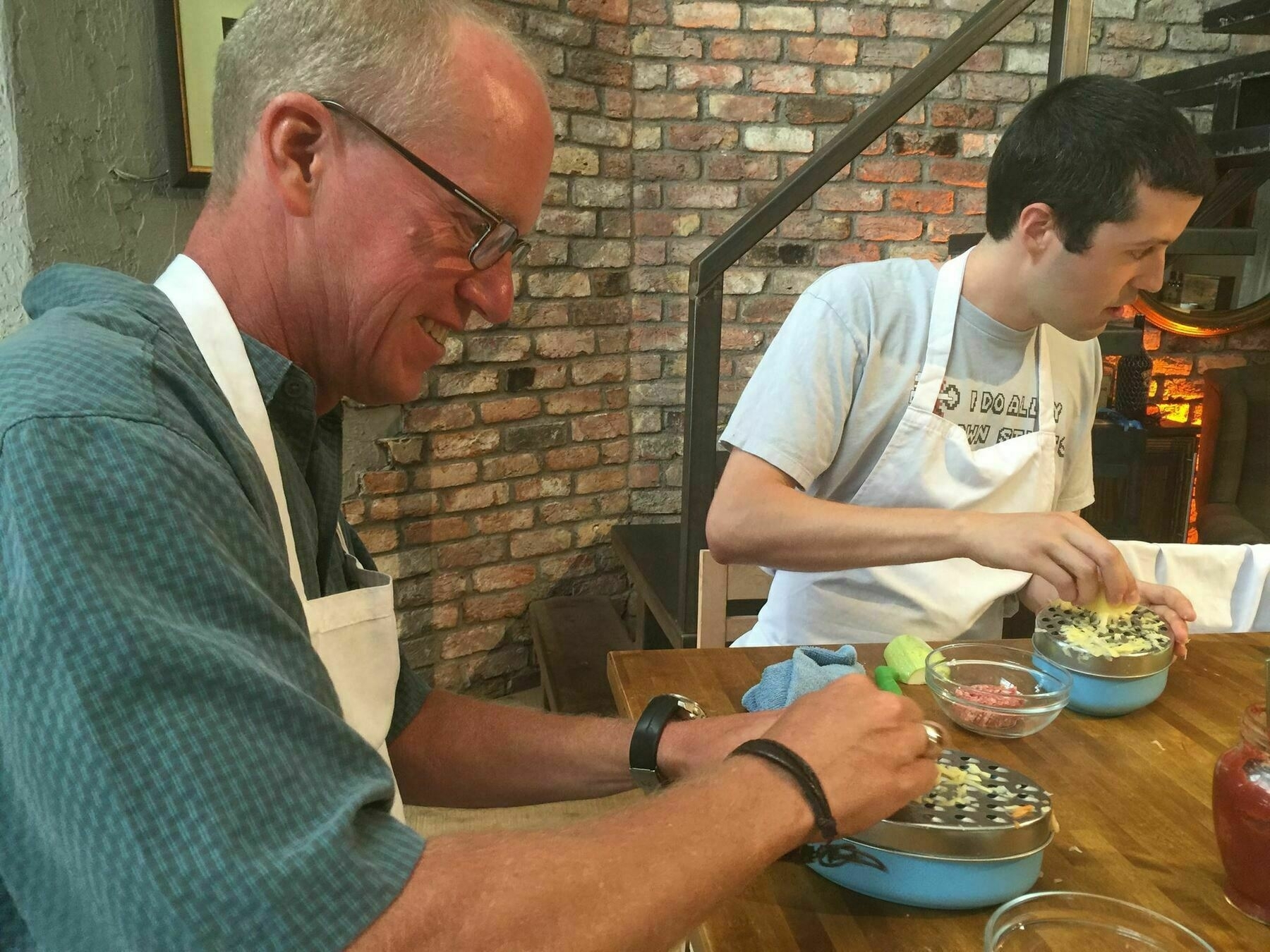
Evening Concert in Ephesus
Evening Concert in Ephesus
The cat, of all things, stole the show. Earlier in the day we had learned about the cats of Ephesus. Apparently the archeological team working on the excavation of the ancient city published a book, but it was about the cats rather than about substantial archeological issues.
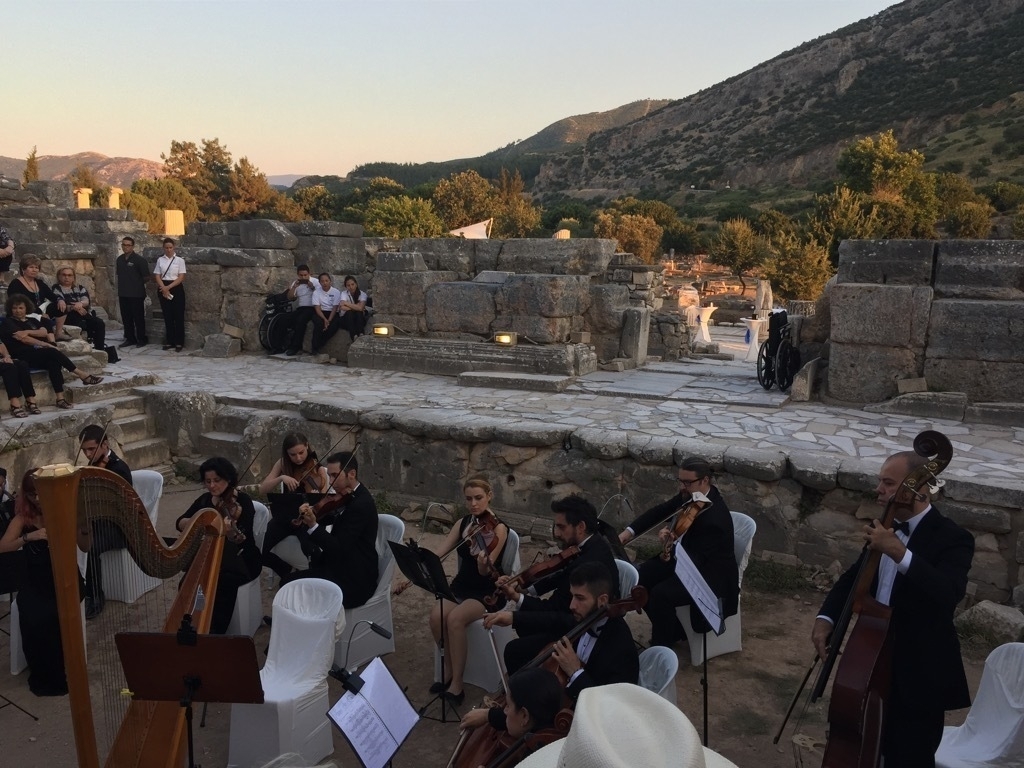
So, it was no surprise that when 500 of us had settled into the Odeon for a 13 piece string orchestra plus harp, that the cats decided to see what was going on. One of them decided it must have had front row seats, as it seated itself right on top of the stone wall front and center behind the orchestra. Then as the first piece started the cat started to meow. Loud enough that it could be heard alongside the harp. The orchestra got the giggles. The ship’s staff was mortified. Too afraid to grab the cat and drag it out of their they tried to call it (quietly) and the head of guest services tried to shush it! Really, you do not shush a cat. Now, I know this will come as a shock to some, but I am not a cat lover. I barely tolerate their presence. But this was stereotypical cat and stereotypical human behavior at its funniest. I only wish that I had been smart enough to video the whole thing because this is America’s Funniest Home Videos GOLD.
I guess the cat was mostly a fan of the harp, because it moved on after the harpist left the stage. From then on we could really enjoy the music and the small orchestra. The concert was definitely a greatest hits type of concert: Bach: Air, Boccherini: Minuet, Mozart: Eine Kliene Nacht Musik, and Brahms: Hungarian Dance No: 5. The Güçan brothers stole the show in the final number with a Violin versus Viola duel that everyone laughing and cheering.
In between all of this great music was the realization that we were sitting in the Odeon theater of Ephesus. Built in the 2nd century AD we sat on the same stones that Marc Antony and Cleopatra may have sat upon when they were here. The Odeon was the center of city government, and cultural events in early Ephesus. With the sun setting behind us it was an evening we will not forget.
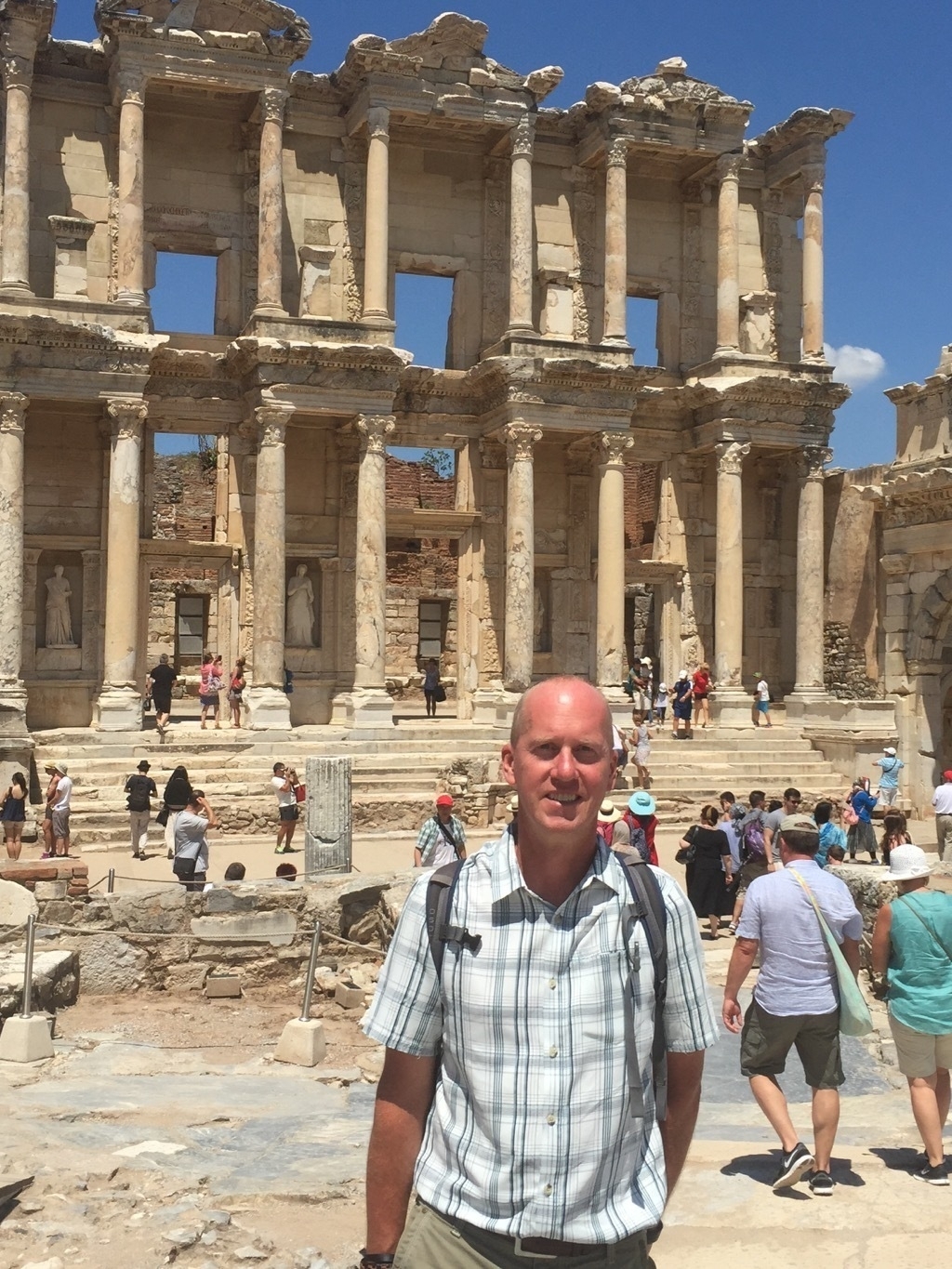
Earlier in the day we did a private tour of Ephesus and it was amazing. About halfway through the tour I turned to Jane and said, “I’m feeling a little bad we did not bring the students down here when we were in Istanbul.” Of all of the ancient ruins of ancient cities we have visited this would definitely be in my top three. The terraced houses, and the library (with its tunnel to the Brothel across the street) are just spectacular.
Our last stop of the day was at the temple of Artemis. There is just one column remaining but from there you can get a great view of this ancient pagan temple along with a Muslim mosque and the Basilica of St. John. Quite a combination.
Biking in Patmos
Biking in Patmos
We may have missed 2 or 3 km of paved road, but other than that we pretty much covered the island of Patmos today. And what a great way to cover it we discovered. Scooters! Not our usual biking fare, but the island is very hilly and we wanted to cover more ground.
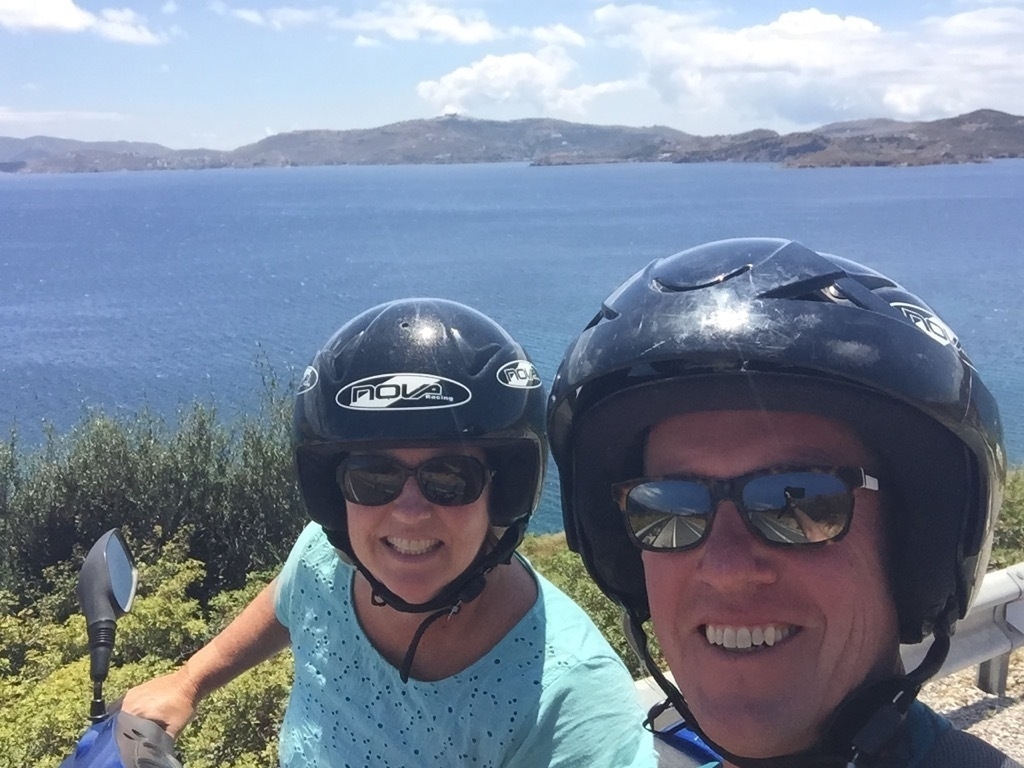
So, we got off the ship and made the short walk to Moto-Leo. A distinctly family run scooter rental operation. Father and daughter, with no deposit or arduous paperwork to rent for the day. Which the daily rental was only 15 euro. So it was also a very cheap way to see the island.
The whole island reminded us of small town living. Although Patmos is a Christian Pilgrimage destination, and they obviously get cruise ships stopping in, the island has not succumbed to that overly touristic feeling. We loved it.
The highlight of the island is the Cave of the Apocalypse, where St. John wrote the book of Revelations. Its pretty small, and they don’t let you take pictures inside, so other than saying it looked like a small cave-like chapel there is not much more to say.
Above the cave sits a monastery and this was our second stop for the day. After parking the scooters and starting the walk up the hill I noticed something that was definitely out of place on the top of Patmos. A “Hawkeye Rd” sign. Really?! An Iowa Hawkeye sign on this tiny small island in Greece. “Iowa Hawkeyes!” I exclaimed. Then I met Jimmy. “Are you from Iowa?” he asked? “yes, from Decorah” I said. “Oh, thats just north of Independence isn’t it?” Clearly this dude knew his Iowa geography! “Yes” I said. “Well, people from Iowa get free coffee, come in, come in!”
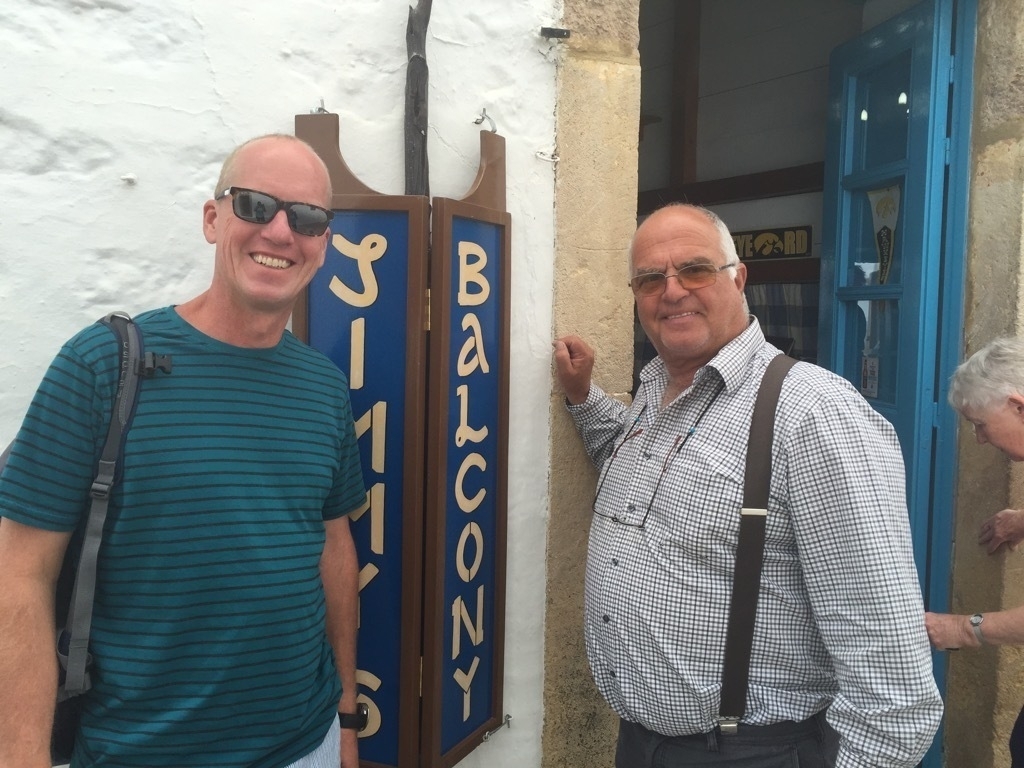
We learned from Jimmy that he had lived in Iowa some 13 years until he inherited this building, which brought him back to the island. He has a fantastic view, and is obviously doing quite well with the restaurant and the gift shop.
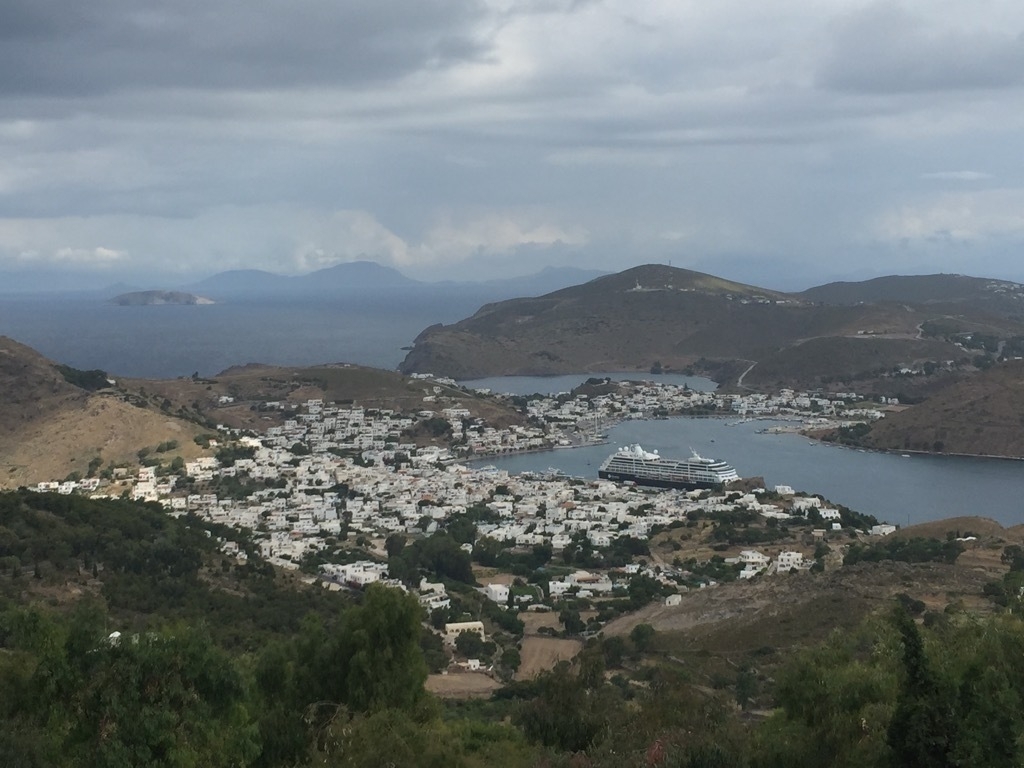
After doing the only two touristic things on the island we took off on our scooters to explore the nooks and crannies of the island. We saw lots of beautiful little secluded beaches and coves that would be perfect for swimming or snorkeling.
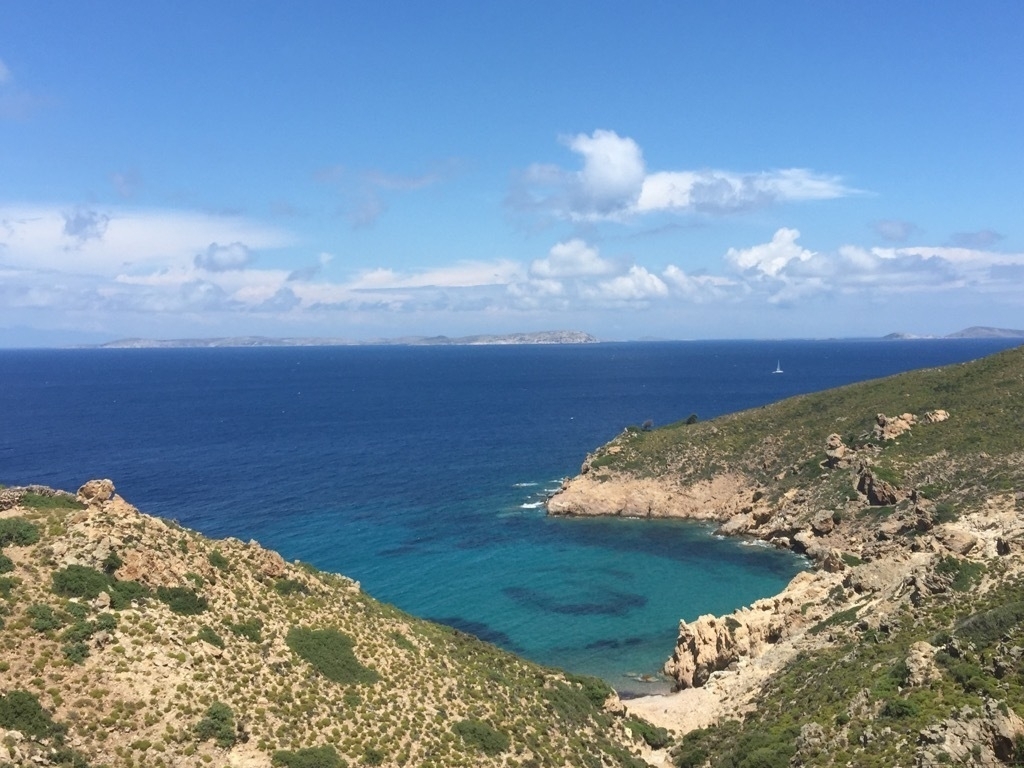
Death March from Fira to Oia
Death March from Fira to Oia
There were six ships in the harbor at Santorini Celebrity, MSC, Azamara, Holland America, and Saga. Azamara was definitely the smallest with just under 700 passengers, but the Celebrity Equinox more than made up for our size. So it was probably over 6000 people descending on the city for the day. In response, the port officials had to stage all of the tender operations so as to not completely overwhelm their ability to welcome people to their city. Meaning, the gondola ride to the top and the poor donkeys carrying people not willing to wait in line for the gondola.
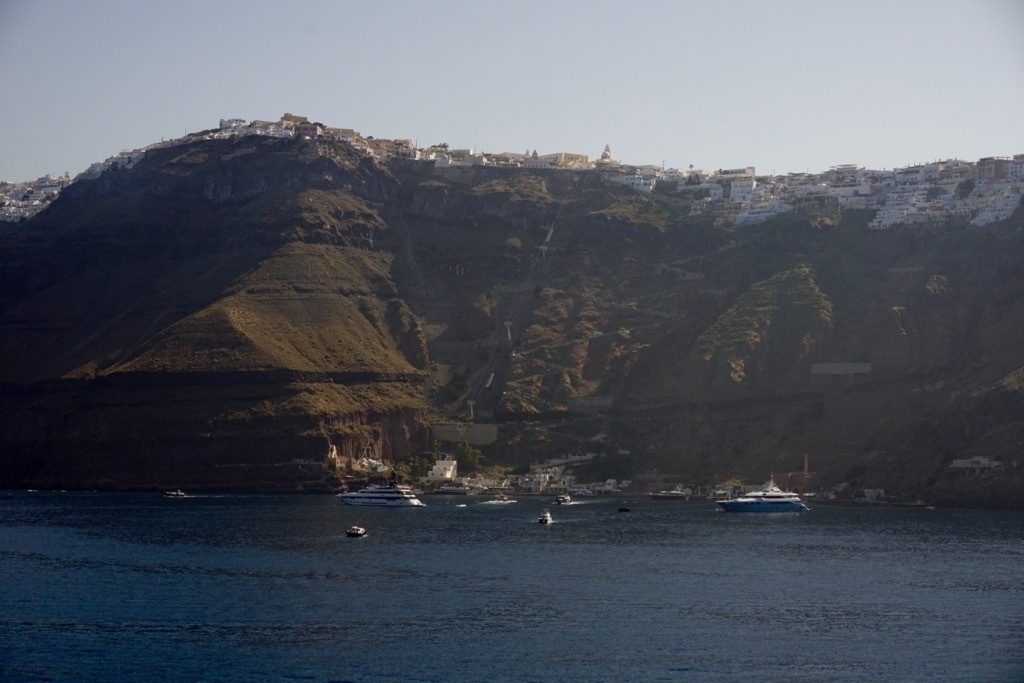
One of the many nice things about the Azamara line is that we stay in port longer than anyone else. Whereas most cruise lines will arrive at a port around 8AM and leave by 5PM Azamara will stay until 10 or 11PM. This has many great benefits in that you can stay ashore much longer, and even have dinner on shore if you like. Or if you have dinner on the ship you are doing it while the ship is anchored! It also goes a long way to reducing the stress around getting out and back from a shore excursion.
Nevertheless, when we arrived on shore the line to take the cable car up the hill stretched across the port. It looked like it was going to take two hours just to get into town but in the end the lined moved fairly quickly and it was only 30 minutes.
The island of Santorini is really just the rim of an ancient volcanic caldera that sticks up above the water. Its easy to see the outline of the circle in this picture:
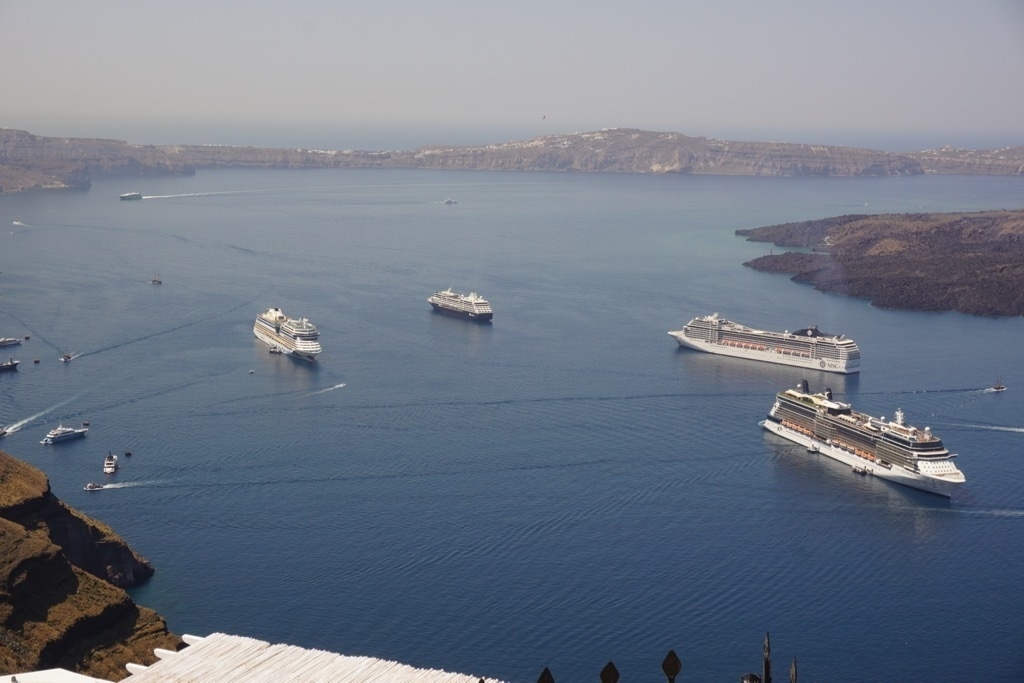
Our goal for the day was to escape the crowds in the city by hiking from Fira to Oia a five mile walk along the rim of the caldera. Through all of the white villages with their shops and hotels. It sounded pretty easy and it didn’t even look like a very long walk when we were starting out. But it felt a lot longer as there was no breeze and the temperature got up to 32 C or about 90 F. The title of this post is a bit dramatic, as it was not that bad of a walk, and although in a few places we walked through volcanic gravel that insisted on getting in our shoes we had 3 hours of amazing views.
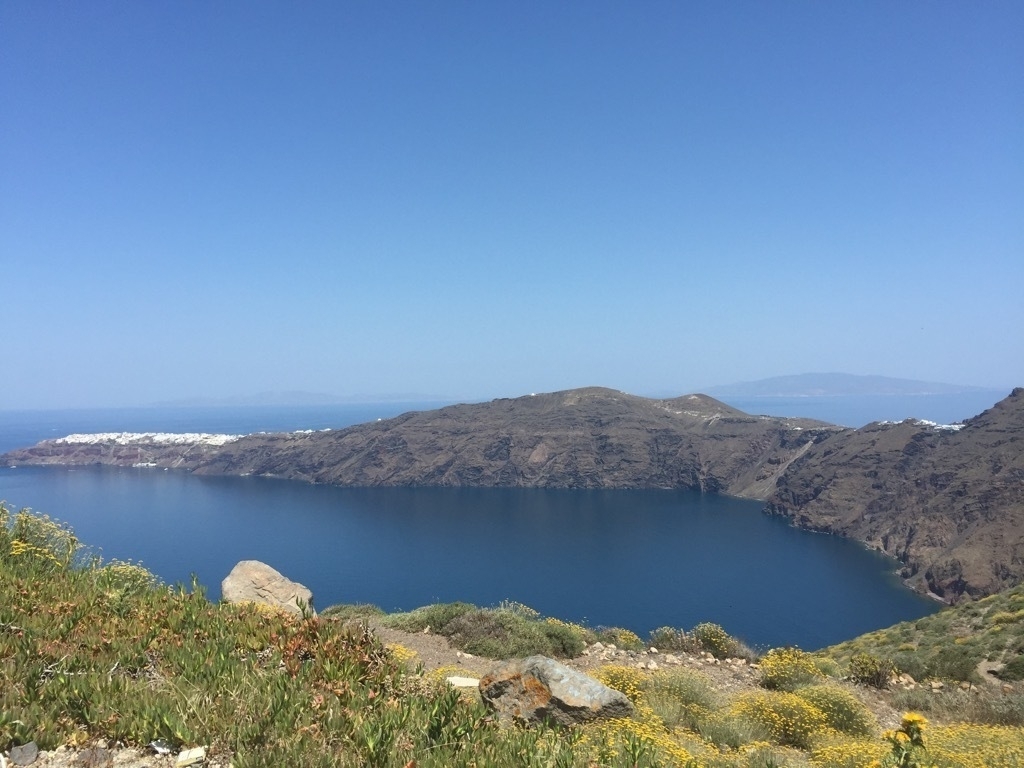
When we arrived in Oia we badly needed a shower, or a dip in one of the many pools we passed on the way. Instead we found a nice little shady restaurant and revived ourselves with some carbonara and a glass of wine. We had escaped the crowds of Fira, seen a lot of beautiful scenery, and worked off a few calories hiking in the heat. It was a great day. Yes, it felt like a forced march a few times along the path to Oia in the heat, but as part of life’s journeys this was worth the effort.
Meanwhile, back on the ship is was Azamara’s white night night. Everyone was out on deck dressed in white and the crew was serving a great dinner. They had the webber kettle going and there were some great greek kabobs and other good food. To top off the evening we watched another great sunset over the rim of the volcano.
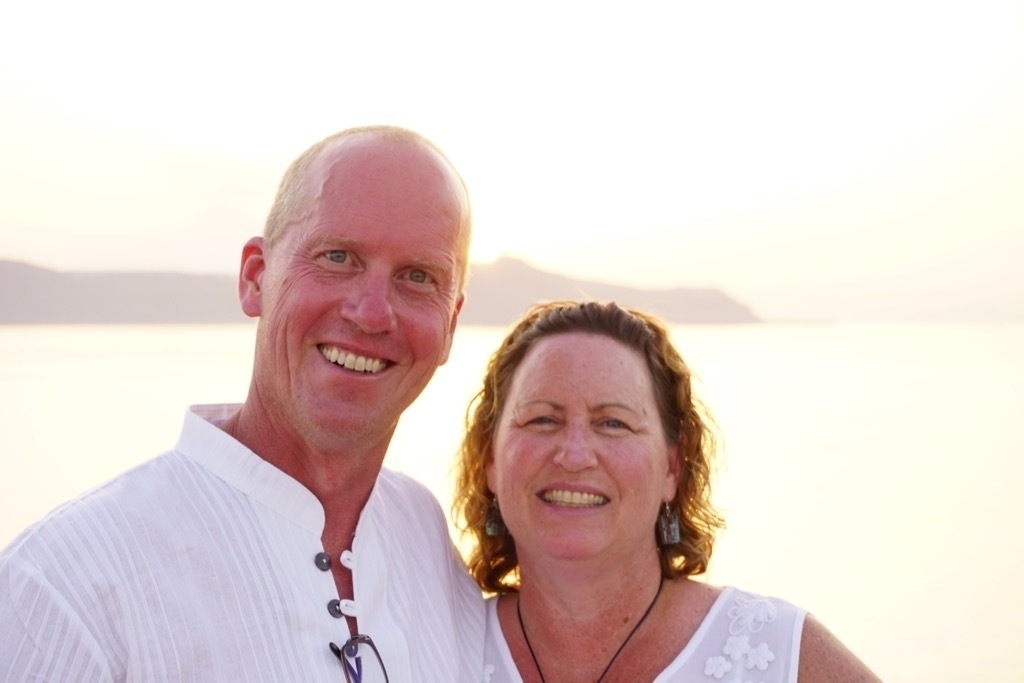
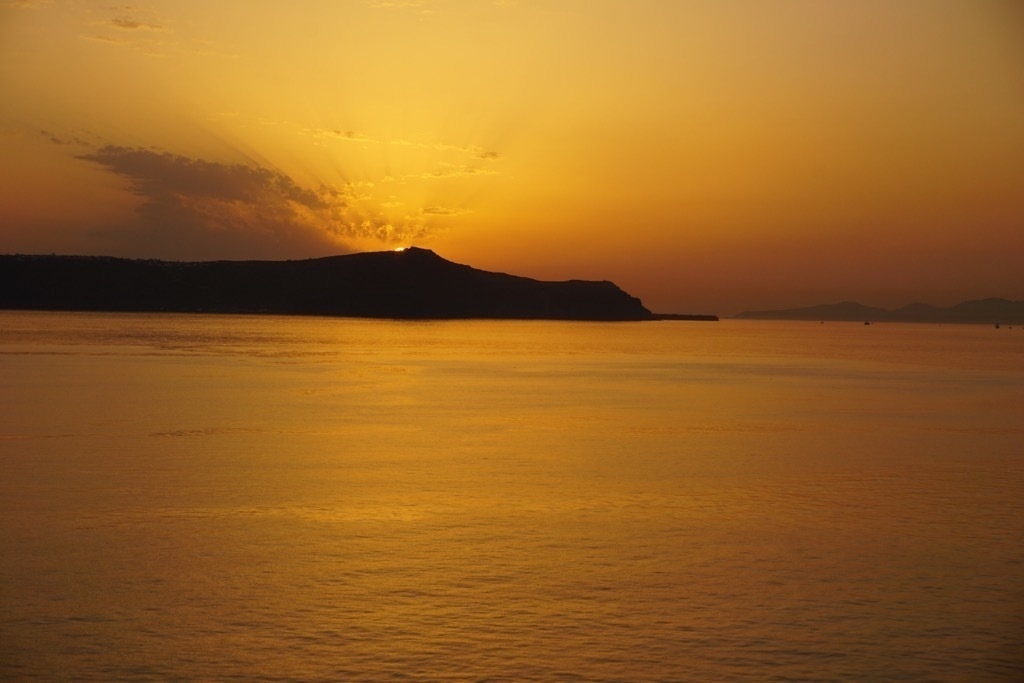
Walking the Walls of Dubrovnik
Walking the Walls of Dubrovnik
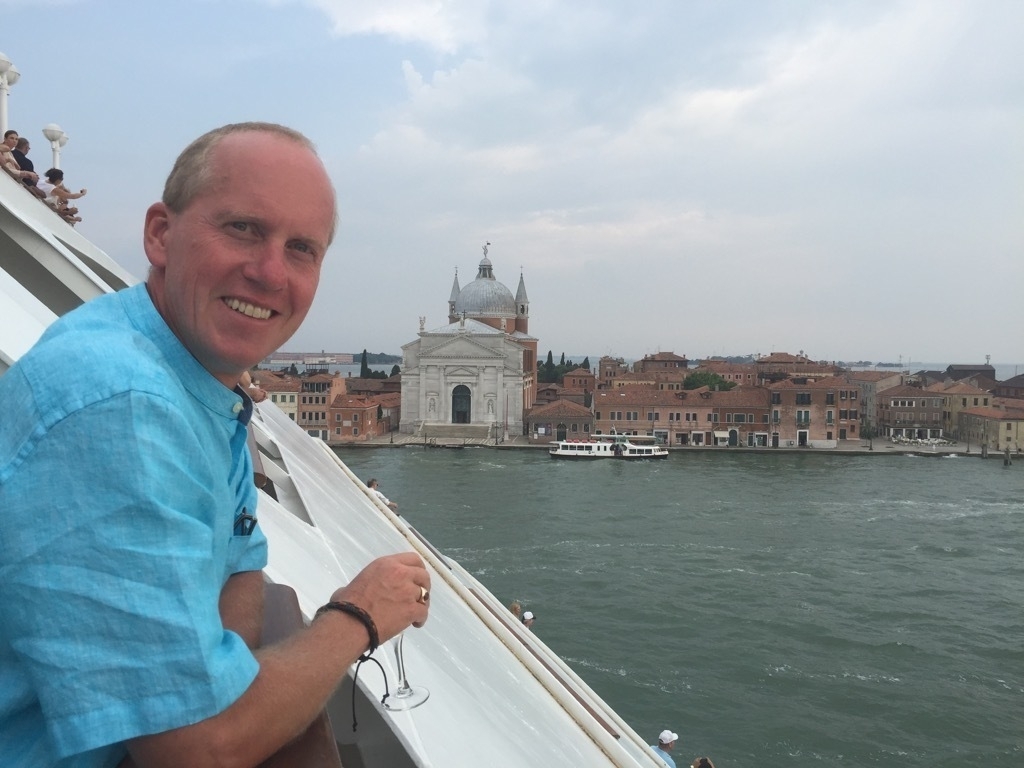
After a beautiful sailaway in venice we traveled to Croatia where our first stop was Dubrovnik. This is a beautiful small city built into the hills on the coast of the Adriatic. Our goal for seeing Dubrovnik was to walk the walls of the old city. The walls are still intact (although patched in places) and provide some pretty amazing views of the harbor as well as the town.
You will notice that all of the homes in the picture have the same red clay tile roofing. But if you look a bit more closely you will see that some of them are quite new and bright while others are old and moss covered. Sadly the new tiles vastly outnumber the old, and are an indication that the house was bombed in the war in the 90’s.
After walking the wall, which is about 1.2 miles we were a bit thirsty so we found a bar, literally through a hole in the wall. It was shady and we had a wonderful glass of the local white wine and just enjoyed watching the ocean and chilling out. As you can see from the picture, the tables and chairs are scattered over the natural rock formation and so the waitstaff had to be quite agile.
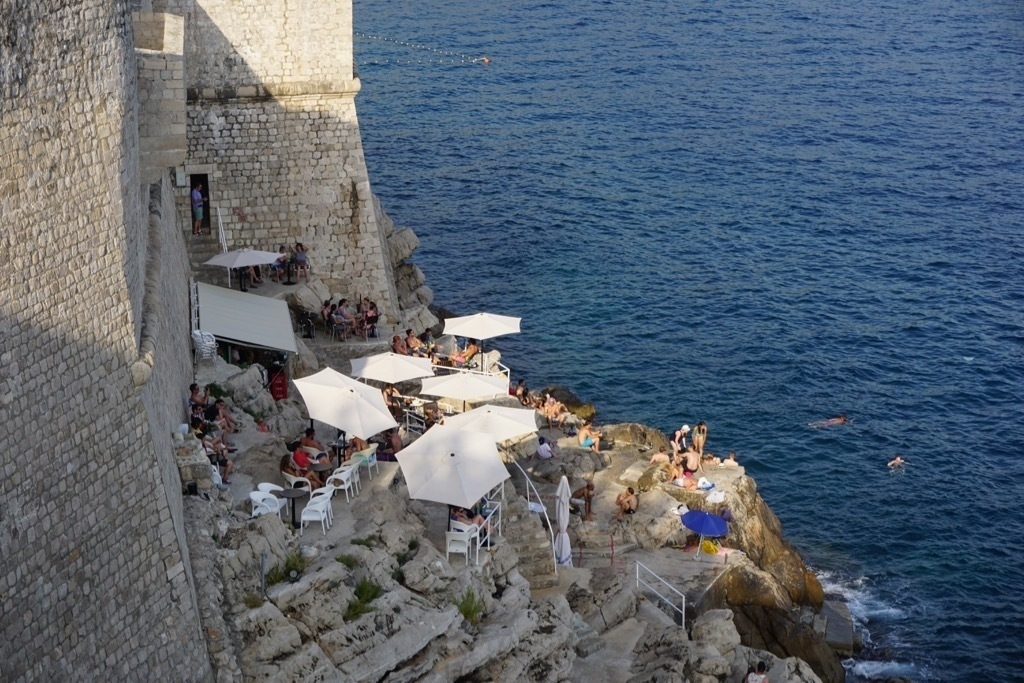
Later that night we had reservations in Prime C, one of the great specialty restaurants aboard the Journey. As we were getting ready for dinner we got to enjoy a spectacular sunset from the comfort of our deck on the back of the ship.
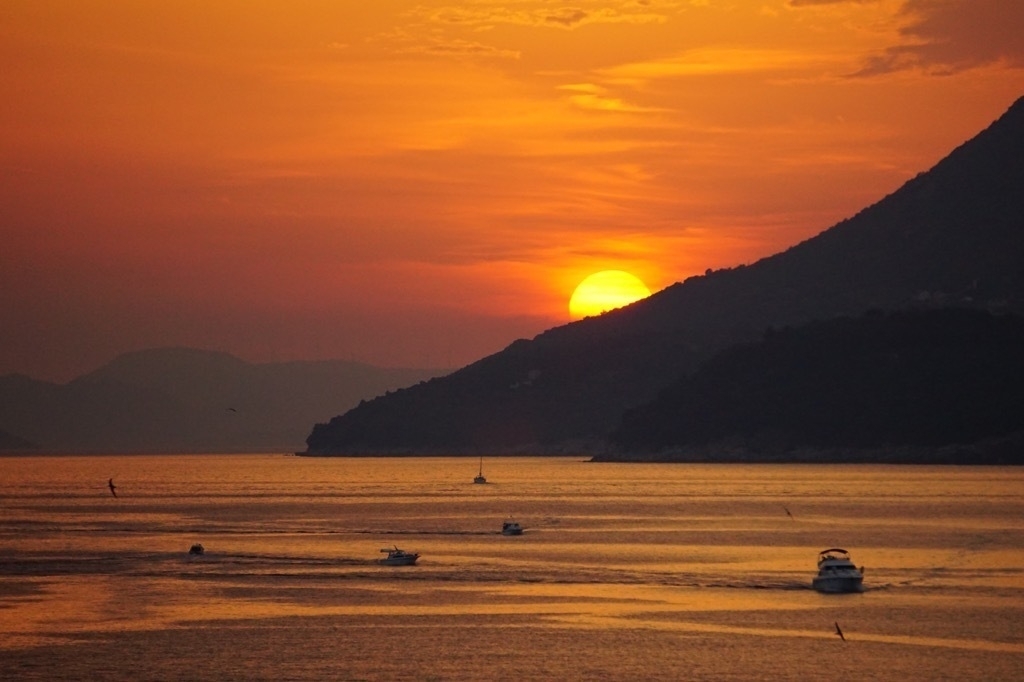
We have had great meals aboard the ship in Aqualina and in Prime C. Last night was even better as we were able to attend the Chef’s table. Where we had an amazing meal with wines that had been paired with each course by the sommelier. The menu consisted of Lobster and Avocado Salad with Honig Sauvignon Blanc, Smoked Tomato Veloute with Conundrum White blend, Surf and Turf Giant Prawn with a Braised Short Rib Croquette) with Schug Pinot Noir, then New Potato Crusted Sea Bass with Lincourt Chardonnay followed by International Cheeses with Toad Hollow.
Lake Como by Lake
Lake Como by Lake
The conversation started like this:
Incoming: Robert, I am not available now, and I have a funeral to go to at 4, but I can meet at 5:15
Me: Sorry, wrong number no robert
Incoming: Oh, Thanks
Incoming: Did you want a boat?
Me: Yes, I had called about a boat, but I talked to Moreno
Incoming: OK, you better give me the time and details because he will forget.
This is was that our reservation to rent a boat to take around the lake on our own was confirmed with Julia.
The next day we picked up our little 16 foot boat with a 40HP Honda engine at 11AM and after confirming that I had driven a boat before I was given very brief instructions, the location of life jackets, and off we went. It was a great way to see part (a very small part in fact) of the lake.
We cruised by the villa used in James Bond’s Casino Royale past the town of Magnerre by many other villas and great lake front property.
rest and relaxation on lake como
After cleaning up the flats and saying our goodbyes to all of the students Jane and I are now comfortably ensconced in Villa Monte right outside the small town of Varenna on Lake Como. We will be here for a couple of days before driving to Venice and boarding the Azamara Journey for an eleven day cruise through the Greek Isles.
By design this part of the post-Malta holiday has been to read and relax, so there’s not a huge amount to write about. But Lake Como is so beautiful that it is worth posting a few pictures from a short hike we did yesterday and some pics of the lake taken from the terrace of our apartment.
We are not in heavy sightseeing mode, just a few hours each day. The rest of the time we are relaxing and eating and trying some Italian wine. Thursday we are renting a boat and taking to the water on our own. It makes me miss my Moomba very bad, but it will be great to get out on the water and view some of the huge villas on the lake from the water side.
saying goodbye to malta
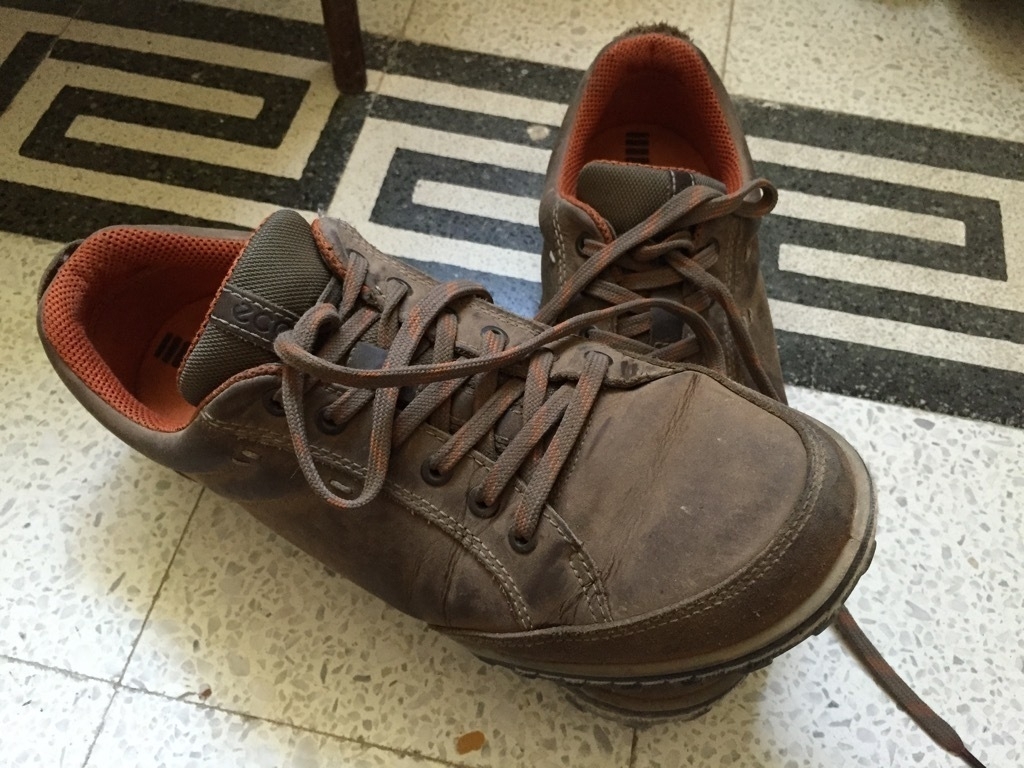 These are my shoes. I bought them for the great adventure of 2015, I started to wear them on January 1 when we left the USA. According to the health app on my iPhone they now have 647 miles on them. Much of that has been accumulated during our time in Malta and our travels around the Mediterranean with Angel, Ben, Emma, Erika, Ethan, Jenna, Katie, Meredith, Meredith, Olivia, Rachel, and Tricia, hereafter known as our kids, or our Malta students. What started out as a funny offhand comment, referring to Jane and I as Mom and Dad has come to feel more true over the few months.
These are my shoes. I bought them for the great adventure of 2015, I started to wear them on January 1 when we left the USA. According to the health app on my iPhone they now have 647 miles on them. Much of that has been accumulated during our time in Malta and our travels around the Mediterranean with Angel, Ben, Emma, Erika, Ethan, Jenna, Katie, Meredith, Meredith, Olivia, Rachel, and Tricia, hereafter known as our kids, or our Malta students. What started out as a funny offhand comment, referring to Jane and I as Mom and Dad has come to feel more true over the few months.
I’m starting this post on our penultimate weekend with our group, I am in Rome with Jane and Josh to take in an AS Roma football game tonight. Some of our students are in Florence for the Nordic choir concert, and some of them are back on Malta (behaving themselves). Its good to have a bit of physical distance to help put things in perspective.
I have also been reading each student’s final journal or blog entries, and I must be turning into an old softie (good thing I have the summer to fix that) but I find myself choking up about something that each student has written. It is true that these past few months of living and traveling together have turned us into an odd sort of family. I’d be happy to adopt them all if I could get that guy in Marrakesh to make good on his offer of 20 camels apiece. I’ve spent a bit of time lately looking back over all the pictures we have taken. I put together this gallery of our group photos. If you look at the first group photo in Malta and in Rome, and compare that to the last group photo this week, can you see the difference? Look at the group in front of the pantheon, this group was just getting to know each other, barely acclimated to the Mediterranean time zone. Now look at the later photos, photographic evidence that we have come together as a family.
So, what have I learned about myself this semester? What are my own conclusions? This heretofore unpublished entry written in Cambodia sheds a bit of light on the recurrent theme of living simply.
Conclusion number one: I can live a more simple lifestyle and live “in the moment”.
As I read over my early posts, and remember back to the end of January when we first arrived on Malta, I am going to admit that the following thought crossed my mind: Leave this flat NOW, and check-in to the Meridien until it is time to fly home (business class). I am very glad that I did not do that. Living in the cold, damp, drafty, loud, and then warm, humid, dusty, loud, almost-but-not-quite-a-place-I-call-home has been an important experience. Now that the end is in sight, I am glad that I had the experience of these last four months.
The elves at Amazon.com must be worried about me, as I haven’t ordered anything from them since December! I have lived with the same ten shirts and six pairs of pants for the same period. Other than going out to eat the material expenditures we have made so far this year are extremely minimal. OK, I am not totally reformed as I have a new Apple Watch waiting for me back home. But it was a good experience for me to not consume for a while. Hopefully this will carry over back home where the temptation of Amazon Prime second day delivery makes the accumulation of stuff all too easy.
What does it mean to “live in the moment?” For me it means accepting life as it happens. It means taking the time to enjoy each moment as it comes along, rather than always thinking about what is coming next. Because I have not had daily class responsibilities, I really have been able to live in the moment for most of the last four months. OK, I am still a worrier; I am always thinking about the worst case scenario, and what to do if said scenario becomes reality. I am a planner, and a goal setter, I am always thinking about next week, next month, When will my next exam be? What do I need to do for class next week? But this semester I haven’t really had any of that to think about. I did worry about some parts of our travel (Morocco, Istanbul…) But, our evening meals were typically planned at about 15:00 when I walked to Meats and Eats to buy whatever we were going to make for dinner.
My time during the day was spent walking back and forth to the University. I have subscribed to several podcasts and am now a regular listener to them. I’ve never had time for podcasts before. I don’t know why. I spent time in class, listening and soaking up lectures on Maltese history and current issues. I spent time in our flat, and in my office at the IT Faculty building sending countless organizational emails and working on projects and hacking.
Conclusion number two: Follow your passion.
While this may not be a discovery of the semester, it was certainly a strong affirmation of this oft espoused philosophy. I like to tell the students in Senior Project that: “If you don’t wake up in the morning thinking about what you want to accomplish during the day, you ought to be thinking about finding a new job.” Now, showers aside, I think that every day in Malta I did wake up and have a great excitement about what I wanted to accomplish during the day. Some days it was the excitement of a field trip, other days it was waking up in Morocco or Istanbul know that a day of discovery was in store, but even on the rainy days of February I had research and thinking to do that was very exciting.
In fact maybe one of the best things about our time on the island was that it gave me time to think. I spend a lot of time doing back home, and it is hard to carve out time to really step back and rethink things. Good things happen when you take the time to think instead of do. I feel like all of the projects I have been working on Skulpt, Runestone Interactive, and the classes I will teach next semester have reaped the benefit of taking time to think.
Conclusion number three: Push yourself outside of your comfort zone, good things will happen.
I have written a lot about pushing myself beyond my comfort zone in the last six months, but it has been very exciting to see the students do likewise. They have all grown this semester, becoming more self confident, more self reliant, and maybe more willing to take a risk. Whether that be jumping off a rock into the Mediterranean, or immersing themselves in other cultures. For me it may have been simply embracing my part-time role as a student of history and current issues of Malta this semester that pushed me to a new appreciation of history and culture. It was also surely the experience of living in a flat that is much less luxurious than back home.
Conclusion number four: Be thankful for the people who support you.
Jane and I joke that we are excited to get back home so that we have more adults to talk to. Not that our students are not adults, but we don’t have the same conversations with twenty two year olds as we do with our fifty year old friends. In some ways this has been a bit of an isolating experience for the two of us. But we have grown used to it. The silences are OK, as we know we simply don’t have anything else to say at the moment.
But, through it all Jane has been a fantastic partner in keeping this program working smoothly. The work she has put in on our travel plans is, extremely detailed, thorough and time consuming. Planning a trip takes patience and hours of research. I know I appreciate it and so do the students. It always amazes me when we arrive somewhere and she knows exactly where to go and which direction to turn, while my head is swirling in confusion. My advice to Ethan and Ben is to follow my lead and “marry above your station.”
I would also like to take this opportunity to publicly thank Corby Preus and Jon Lund in the Center for Global Learning back at Luther for all of their support. Corby does an amazing job of helping with paperwork, and re-answering my questions about pretty much everything she has already explained to me at least once, and sometimes twice.
Here in Malta I would like to thank Dr. Emanuel Buttigieg for coordinating the History of Malta course, I know I have learned a lot this semester, and it takes a lot of coordination to organize all of the lecturers from many different departments on campus. And finally to Rachelle Mifsud for whom there is no request too large or too small for her to help out with. Scheduling transportation at the last minute, or helping with final exam schedules. Thanks!
Conclusion number five: Focus on the good
I think this is a nice one to save for last, and it is a fairly recent conclusion, and clearly one that will take some practice for me. The last Paideia lecture we did an exercise where we had to think about Malta from the perspective of each of our five senses. What stands out:
-
sight – yellow limestone buildings, dog poop on the sidewalk
-
sound – honking horns, the “angry” maltese language
-
smell – Pizza and the salt air
-
taste – Maltese wine, Wild Boar Pasta
-
touch – rough limestone, and cold tile
Many of us commented after class about how negative most of the things we came up with sounded. Even though the native Maltese professor came up with his own similar list. Familiarity breeds contempt as the saying goes?
But I think the important lesson was summed up by a couple of the students in their own final blog posts in which they said. “I do not want to remember Malta for the dog poop on the sidewalks or the horns honking outside my bedroom window” Rather they , and I, will choose to remember Malta for the good stuff: The crystal clear water, the blue waters of the Blue Lagoon, St. Peter’s Pool and Golden Bay, the majestic cliffs of Gozo as viewed from the Ocean or the cliffs of Dingli from the land. The Neolithic temples of Hagar Qim and the mysterious Hypogeum. The beauty of the Auzure Window. The brightly colored Maltese boats in Spinola bay. And, yes, the ever present yellow limestone of Sliema and Valletta. This is the way to remember Malta.
Don’t sweat the small stuff my dad used to tell me. Let the unpleasant annoying pet peeves fade away.
Not Goodbye
Although this will be my final post from Malta, this is not the end of the blog. In less than a week, the students will be on their way either home or to european travel for part of the summer. Meanwhile Jane and I will be finishing up our own Mediterranean experience with a few days in Lake Como and then a Cruise from Venice down the Dalmatian Coast and through the Greek Isles, ending in Istanbul. We planned this as a celebration of the end of our time in Malta, and I’m sure it will be, but right now we are both facing this last part of the journey with mixed emotions. The call of home is very strong, and I know that if we simply boarded a plane to Minneapolis we would be ecstatic. But the comfort zone of home will have to wait another twenty days. Its really not all that much when you consider we have been gone 159 days already, and more adventure awaits us, you can be sure I’ll continue to write about it here.
cooking in malta
The first thing I should say about cooking in Malta is that there are around 600 reasons not to cook within walking distance. Some of our favorites are:
-
Guzé — OK, I love Pappardelle with wild boar sauce. I could eat this once a week.
-
Pepperoncino — The Rosettes (little bowls of pappardelle and proscuitto cooked in cream sauce) are to die for. Plus a totally small town friendly vibe that you just can’t beat.
-
Piccolo Padre – Eat pizza right out over the water. Diavola yum!
-
Wigi’s Kitchen — You can pick your fish or your steak right at the table. The window seats have an awesome view of Balluta bay.
-
Kebabji. – The students introduced us to this one. I think of it as “the chipotle of Sliema.” My favorite is Chicken-shish with Tabbouleh, Hummus, Couscous, Harissa, and Sesame sauce. Actually its the only thing on the menu I’ve ever ordered, but why mess up a good thing.
I’m going to divide the rest of this post into three parts, that roughly describe the three stages of cooking I have gone through here. I call them:
-
Subsistence cooking
-
Getting over it, and getting on with it
-
Grilling season arrives
Subsistence cooking
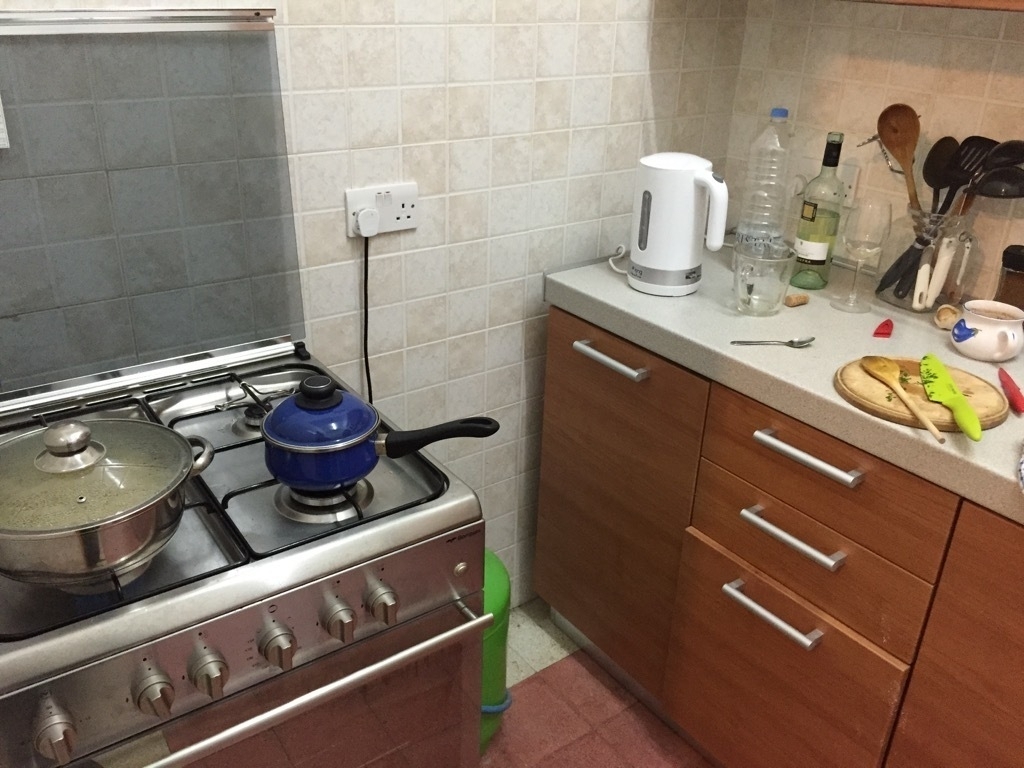
So, I admit when we first got here, I went through a bit of culture shock. As I’ve mentioned before, it was colder inside our flat than it was outside, and it was rainy, and dreary most of the time. Our kitchen was, and still is, tiny and isolated from the rest of the flat. The cutlery was dull, and the pots and pans old and dented. We must have set aside 50 knives and a dozen pots and pans from the three flats to be disposed of.
We made our first trip to a grocery store called Lidl, a german chain. All of the ingredients were labelled in anything other than language. There was little produce or fresh meat, and it was nowhere near our flat. Next door to us is a small corner market, at the cash register is a young boy who ought to be in school but never is. They have produce outside, but no fresh meat, and a totally random selection of dry goods. There is a large supermarket about 1km away, and it has a lot of things. Going to the Park Towers supermarket for the first time was like an adventure. Taco shells! A butcher, a cheese counter with Parmeggiano Reggiano, hot sauce, spices, asian ingredients.
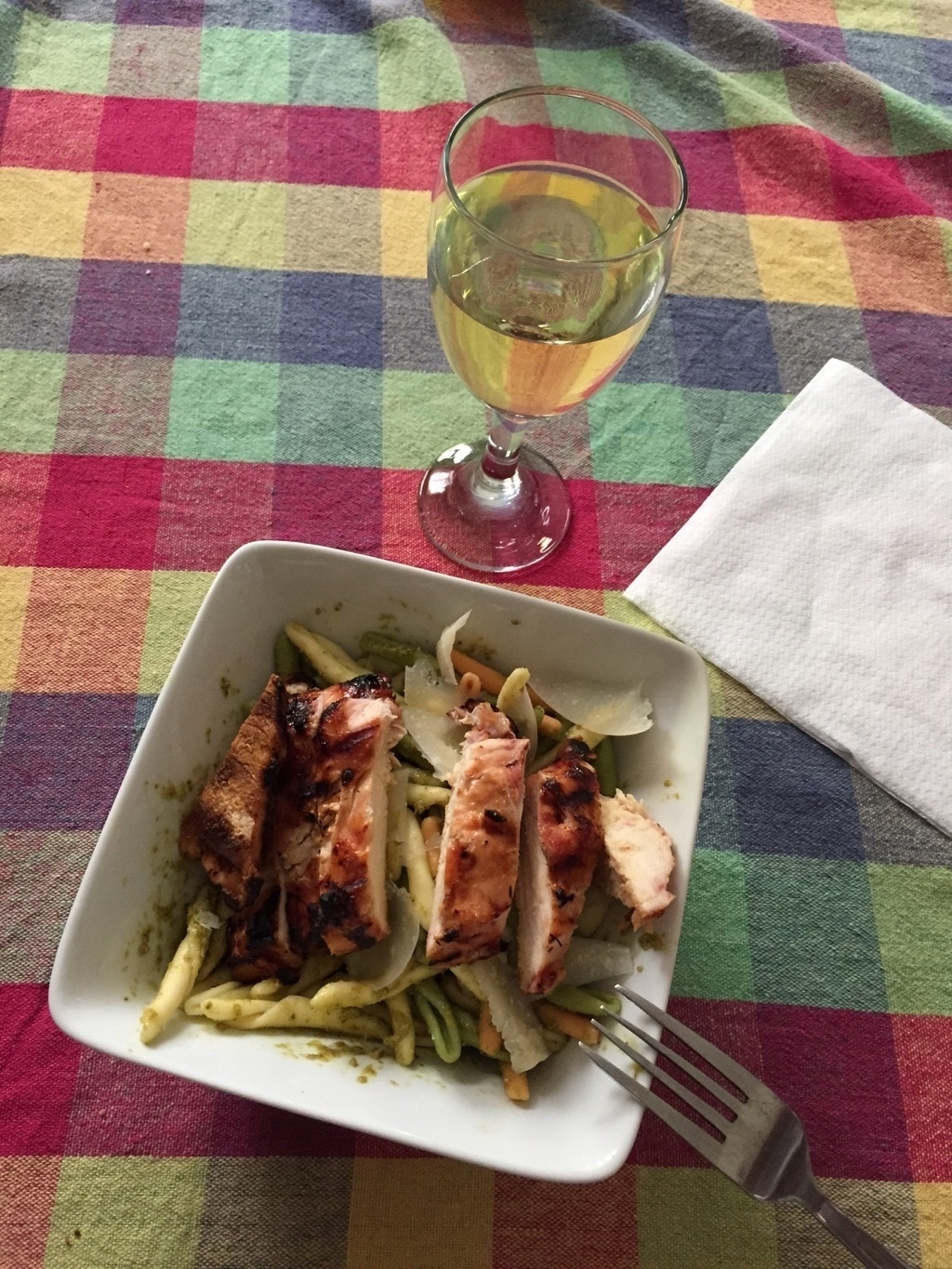 The first meal we cooked in the flat was a grilled cheese and ham sandwich. Not regular ham but delicious prosciutto ham, and tomato soup. Sound familiar? I’ll bet that is the first thing that many people learn to cook. I’ll bet it was two weeks before we cooked an evening meal in the flat. In part because going out for dinner meant that we had some place warm and heated where we could go for a few hours before coming home and huddling under our covers. The first true good meal I cooked was this pesto with chicken. We quickly discovered that we don’t care too much for pesto in a jar even this close to Italy. We also learned that vegetables and fruits are much more seasonal here in Malta than in America. So we had to wait a few weeks before basil came into season to make a good home made pesto.
The first meal we cooked in the flat was a grilled cheese and ham sandwich. Not regular ham but delicious prosciutto ham, and tomato soup. Sound familiar? I’ll bet that is the first thing that many people learn to cook. I’ll bet it was two weeks before we cooked an evening meal in the flat. In part because going out for dinner meant that we had some place warm and heated where we could go for a few hours before coming home and huddling under our covers. The first true good meal I cooked was this pesto with chicken. We quickly discovered that we don’t care too much for pesto in a jar even this close to Italy. We also learned that vegetables and fruits are much more seasonal here in Malta than in America. So we had to wait a few weeks before basil came into season to make a good home made pesto.
Getting over it, Getting on with it
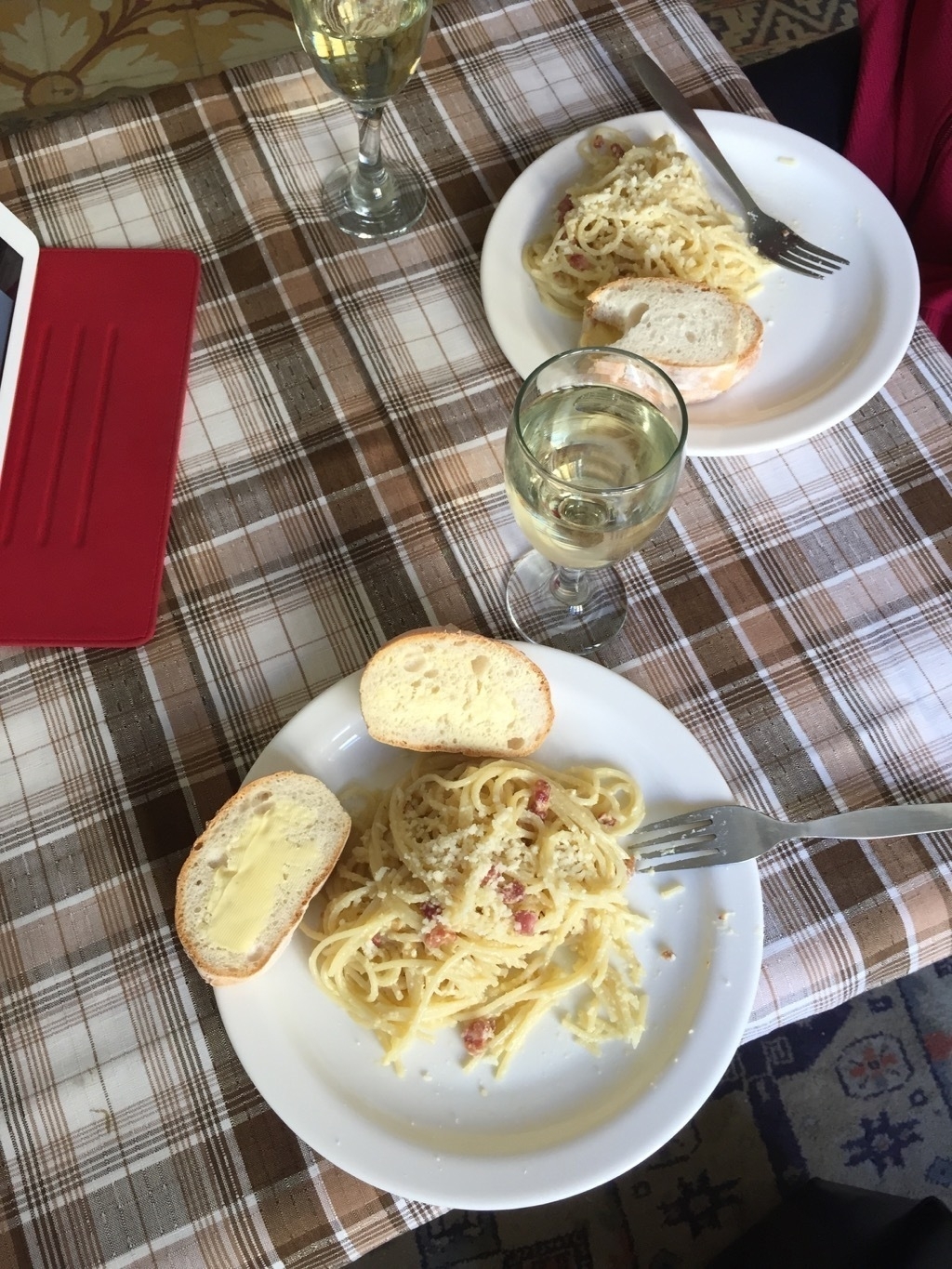 Eventually, the temperature warmed up and we got more comfortable with our surroundings and we reached the point where we could not stand to eat out anymore and so we started cooking in the flat more. One of my goals was to learn at least one new recipe while we were in Malta. I figured it would be so me kind of seafood, but it turns out the Maltese don’t really eat that much seafood despite living on an island. After our trip to Rome I realized that what I really wanted to cook was spaghetti carbonara. For some reason I have missed out on this delicious yet simple dish my entire life. This is one of those simple yet delicious Italian dishes. Eggs, wine, noodles, cheese, and good cured ham or bacon. I have been making steady progress on mastering this dish, but I still have a ways to go before it will live up to that first night in Rome.
Eventually, the temperature warmed up and we got more comfortable with our surroundings and we reached the point where we could not stand to eat out anymore and so we started cooking in the flat more. One of my goals was to learn at least one new recipe while we were in Malta. I figured it would be so me kind of seafood, but it turns out the Maltese don’t really eat that much seafood despite living on an island. After our trip to Rome I realized that what I really wanted to cook was spaghetti carbonara. For some reason I have missed out on this delicious yet simple dish my entire life. This is one of those simple yet delicious Italian dishes. Eggs, wine, noodles, cheese, and good cured ham or bacon. I have been making steady progress on mastering this dish, but I still have a ways to go before it will live up to that first night in Rome.
The second thing that made a turnaround in our cooking was learning to shop. Now there are four places that are worth highlighting.
-
O’Ryan’s on the corner
-
The college street mini market (the green market)
-
park towers supermarket
-
Meats and Eats on Dingli
-
all the vegetable trucks
Let’s dispatch with Park Towers first. Big, indifferent to rude staff, distant. Shopped there a couple of times and decided not to go back. Jane has been back a couple of times to stock up on cleaning and bathroom supplies, but we don’t shop there anymore for groceries.
The corner store is great for water, limoncello, Pringles, and the occasional need for baguette and salami. It’s about double the size of my living room, but packs in all of the essentials including frozen meats. The owner and his family run it together. Nine times out of ten when you go in there you would think that the mother is on the verge of killing the father or the son. Or it might just be that most Arabic conversations still sound like arguments to my western ears. Much of the time the cash register is “manned” by a boy who clearly should be in school but is not. I suppose he will inherit the store and so is learning the trade and the family does not feel the need to send him to school.
The green market is much larger than the corner store, and has great fresh baked bread every day. They have a reasonable selection of fruits and vegetables out front, along with canned goods and other essentials. Most of the time the cash register is manned by an old man who has never once rung up an entire order correctly, but he is charming and friendly every time we go to the store.
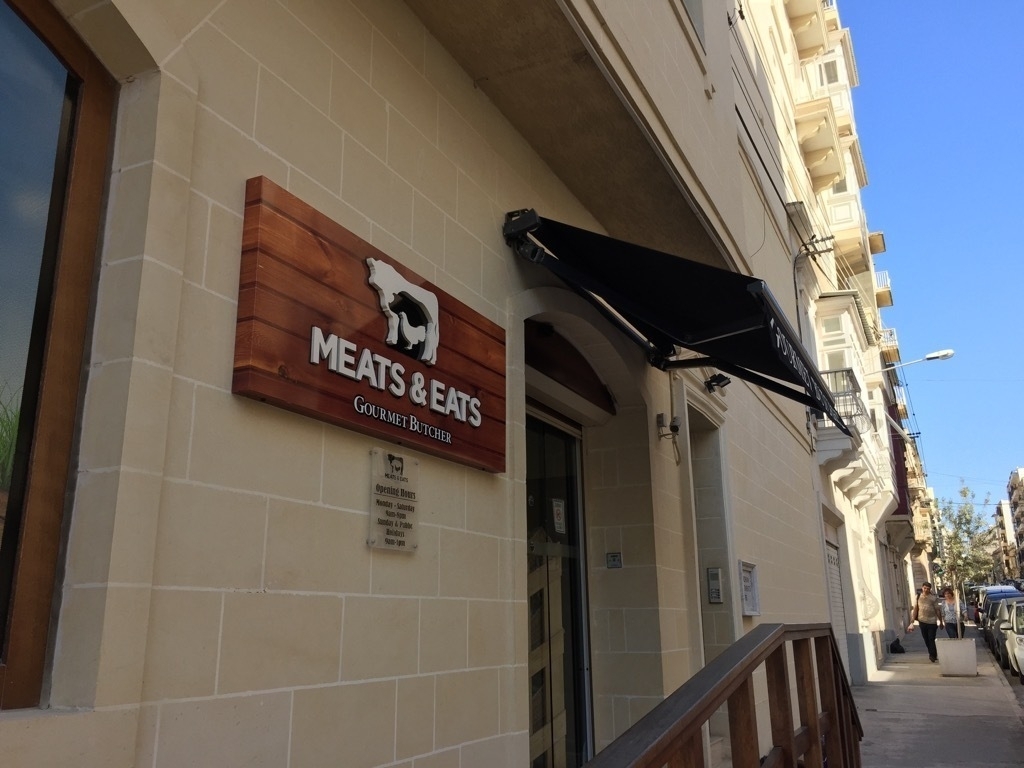 Meats and Eats is probably the single best thing that happened to my cooking during our stay in Malta. The store is bright and clean and staffed by a bunch of friendly Italians. The meat counter is a joy to visit almost every day. It’s the kind of meat counter wher they have several big hunks of ribeye, originating from around the world, and they Will cut you off a hunk of whatever thickness you like. They also have marinated pork and chicken and fresh minced beef and pork. The rest of the store has great gourmet ingredients as well as some nice convince items like prepared curry sauce. The cheese counter has huge chunks of parmigiana reggiano at a ridiculously low price. Next to the checkout counter is a wine selection that is just about as good as anything you can find in Malta.
Meats and Eats is probably the single best thing that happened to my cooking during our stay in Malta. The store is bright and clean and staffed by a bunch of friendly Italians. The meat counter is a joy to visit almost every day. It’s the kind of meat counter wher they have several big hunks of ribeye, originating from around the world, and they Will cut you off a hunk of whatever thickness you like. They also have marinated pork and chicken and fresh minced beef and pork. The rest of the store has great gourmet ingredients as well as some nice convince items like prepared curry sauce. The cheese counter has huge chunks of parmigiana reggiano at a ridiculously low price. Next to the checkout counter is a wine selection that is just about as good as anything you can find in Malta.
I knew that I was going to have a great time shopping at Meats and Eats the morning I decided to give carbonara a try. I went to the meat counter to get some bacon and had the following conversation:
Clint: Sorry sir, we only have streaky bacon today.
Me: Uhhhhm streaky bacon? Ahh, the stuff that just looks like regular bacon to my eye. What’s the difference?
Clint: Very thin, not the good cured pork belly.
Me: Oh, well I’m just experimenting with carbonara sauce so I think the streaky bacon will work.
Clint: Oh no sir, you should not do that. If you are doing carbonara you need the good bacon or one of the packages of pancetta in the case over there.
Oh yes, agreed the lady standing next to me at the counter. Now I am left wondering how I will find this wonderful chunky pancetta back home.
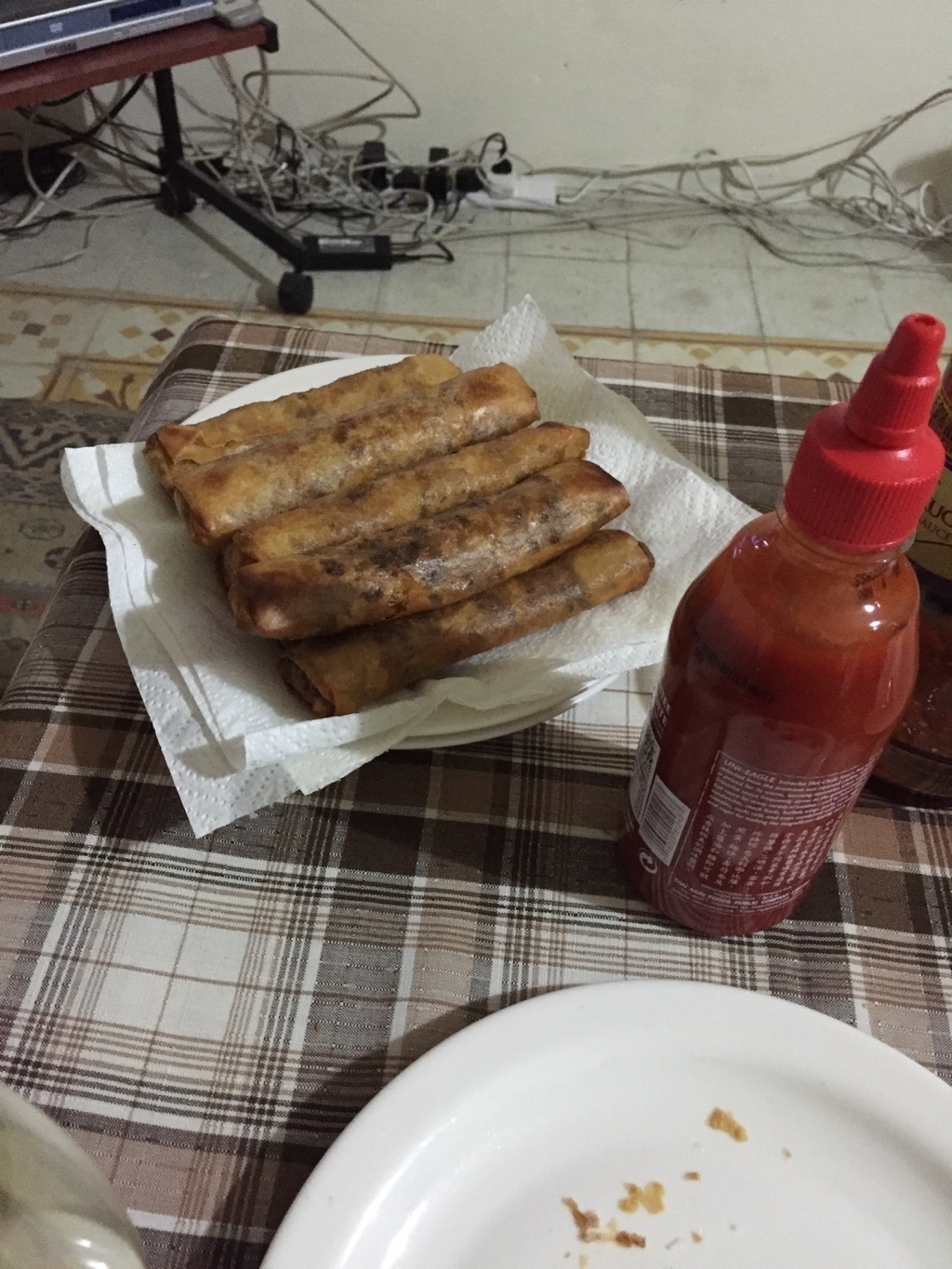 Another thing I’m excited about continuing back home is fried spring rolls! Jane and I had lessons on making these in Vietnam, and were excited to try our hand on our own. When I discovered an Asian market on my walk to school I knew this would become a reality in Malta. Shopping in the Asian market is like Christmas, I see all of these cool exotic ingredients and I want to get them and try them out. Fresh lemon grass, six different kinds of fish sauce, Hoisin, Sirachi, you name it. Now the key to good spring rolls in my opinion starts with the wrapper, and I definitely like the frozen wrappers much better than the dried. They are easier to work with and I like the texture of the end product better. With a little more practice I’ll be ready to challenge my friend Nancy to a Spring Roll Throwdown!
Another thing I’m excited about continuing back home is fried spring rolls! Jane and I had lessons on making these in Vietnam, and were excited to try our hand on our own. When I discovered an Asian market on my walk to school I knew this would become a reality in Malta. Shopping in the Asian market is like Christmas, I see all of these cool exotic ingredients and I want to get them and try them out. Fresh lemon grass, six different kinds of fish sauce, Hoisin, Sirachi, you name it. Now the key to good spring rolls in my opinion starts with the wrapper, and I definitely like the frozen wrappers much better than the dried. They are easier to work with and I like the texture of the end product better. With a little more practice I’ll be ready to challenge my friend Nancy to a Spring Roll Throwdown!
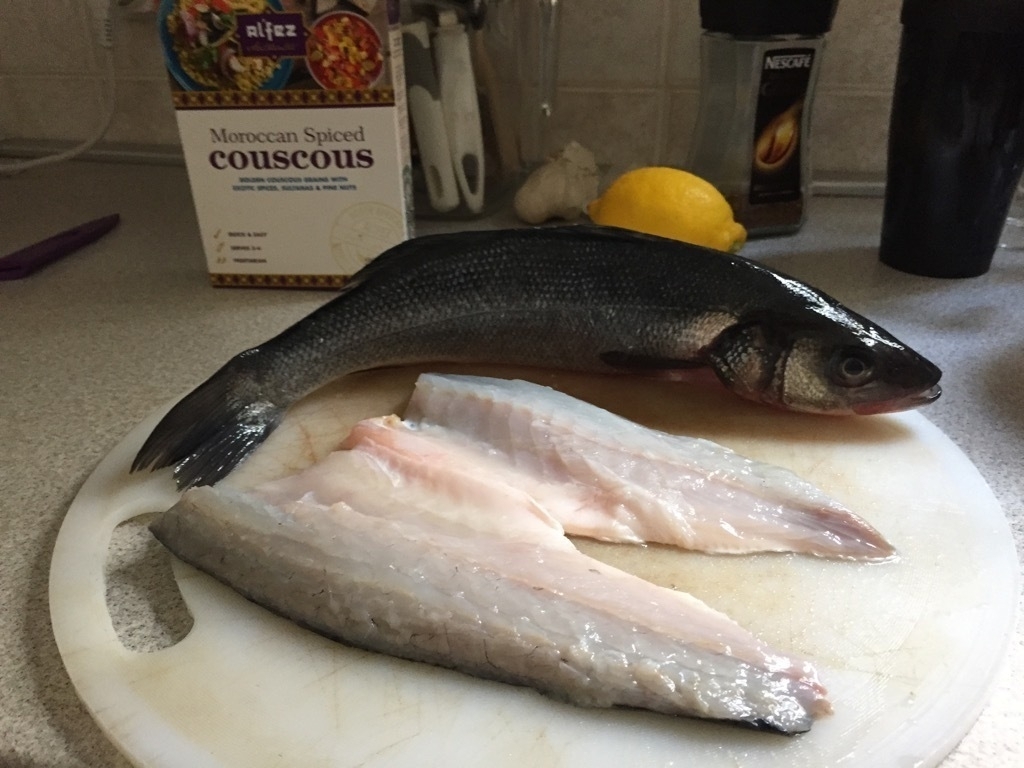 A Sunday morning expedition to the Marsaxlokk (Mar-sa-shlock) fish market provided an opportunity to learn how to fillet and cook fresh caught sea bass. There are many other types of fish available at the market as well, but Jane and I had both watched a you-tube video on filleting sea bass, so that was the direction we went. The market also has huge king prawns, but taking the head and legs off the prawns is a lot of work for my lunch. One thing that amazed me about the fish market was that it was not the least bit fishy smelling. In fact other than the fish market in the middle of Gzira I have yet to walk along the sea here in Malta and think, oh fishy, or ocean. I guess it goes with the crystal clear water.
A Sunday morning expedition to the Marsaxlokk (Mar-sa-shlock) fish market provided an opportunity to learn how to fillet and cook fresh caught sea bass. There are many other types of fish available at the market as well, but Jane and I had both watched a you-tube video on filleting sea bass, so that was the direction we went. The market also has huge king prawns, but taking the head and legs off the prawns is a lot of work for my lunch. One thing that amazed me about the fish market was that it was not the least bit fishy smelling. In fact other than the fish market in the middle of Gzira I have yet to walk along the sea here in Malta and think, oh fishy, or ocean. I guess it goes with the crystal clear water.
One thing that we have really had to work on is finding variety in our diet. Back home we enjoy the cuisine of many different countries all in the same week. Tex-Mex one night, grilling the next, indian or Thai curry after that, italian, vietnamese, pot roast in the crock pot (an American Tagine), you name it, we like our variety. Making tacos is definitely a comfort food that we miss. The ingredients are just about impossible to find. Sour Cream and creme fresh are not the same, The salsa here on the isaland is just not up to par. Finding taco shells is possible at the Park Towers supermarket, but you have to go there to buy them. Then there is the beef, or what the British and Maltese call mince I suppose that if you look at it objectively mince is no worse of a word than ground but having grown up with ground beef, minced beef sounds a little disgusting to my ears.
The other odd thing is the lack of soups. You simply cannot buy cream of mushroom anywhere! So we have gone six months without one of the staple comfort dishes of my entire life, namely beef stroganhoff. The availability of wonderful Parmiagianno Reggiano makes risotto a good comfort fill in, and here we run into the lack of chicken stock. I suppose I could, and should, make my own stock but that takes advanced planning. I’m used to just grabbing a carton of stock from the coop to make my risotto. Here it appears that boiled water with bullion cubes, or a little container of gelatinous chicken stock substance that you disolve in water takes the place of a good stock. It does the trick, especially with a little extra Reggiano.
And finally a word about wine. Maltese wine is surprisingly good, and incredibly cheap. While many of the students pride themselves on keeping it under 3 euros a bottle, I have found many good wines for under ten. My favorites are:
-
ISIS, a rather unfortunate name for a wine in this day and age, but it really is my favorite
-
Maltese Falcon
-
Marsamena – a delicious chardonnay from Gozo
On the subject of wine I would be totally remiss if I did not mention our local wine shop. Owned and run by a young man from the south of France, Vini Culture is a fun place to stop in on my way home from school, or to just run around the corner and grab a bottle for happy hour. The young guy who runs the store is extremely friendly and pleasant. I never stop in there without having an enjoyable conversation about wine and France and all the new things he has on order for us to try. Its hard to understand how he makes a living in a specialty shop like that in the middle of Sliema but I’m happy I got to know him and shop there.
Grilling season
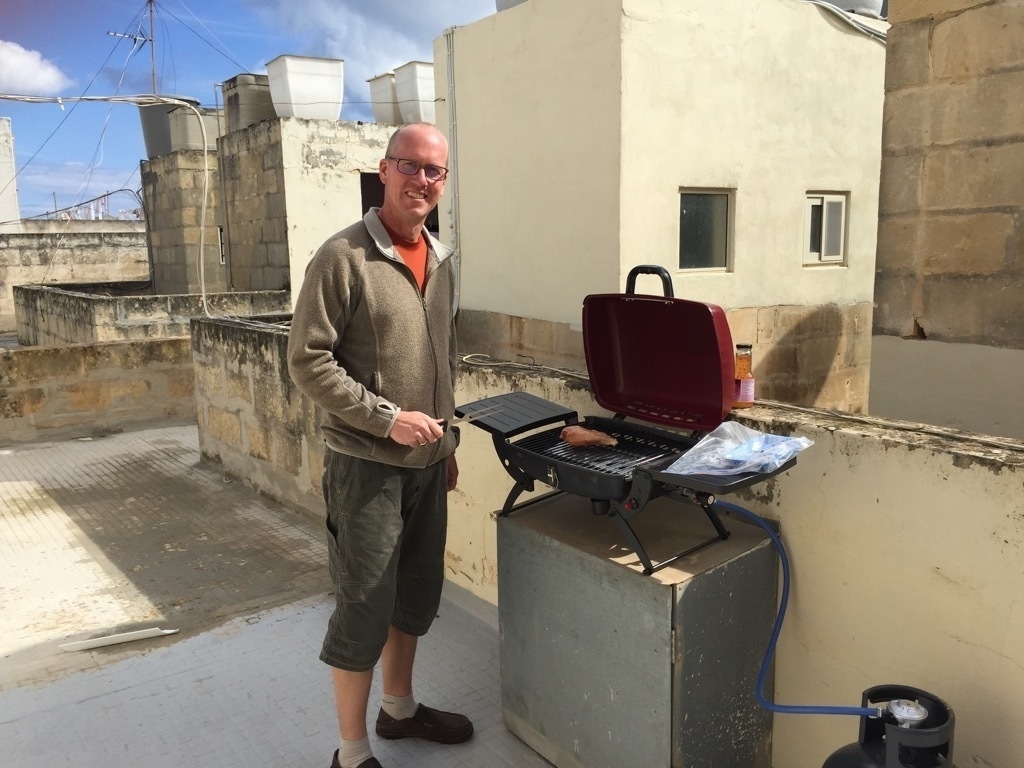
And suddenly grilling season was upon us. The roof was a much sunnier and less windy place. The sun was starting to stay out until a reasonable cooking hour. Meats and Eats has a wonderful pork steak marinated in mediterranean spices, and we can grill that and serve it with some roasted new potatoes from my Sicilian vegetable man. Some fresh baked bread, and some spinach salad with strawberries and vinaigrette dressing.
The Sicilian vegetable guy, I have no idea what his name is, is another great story. Since meats and eats does not sell vegetables, I just walk another half block to this guys fresh vegetable truck. I know he thinks I’m kind of odd because I usually come in and buy one hot pepper, six small potatoes, or one head of garlic, depending on what I need for the evening meal. Its not usually much, and it almost always under one euro.
One day I was buying a pepper and an onion for a total of 40 cents, I had forgotten to put change in my pocket before I left the flat. As I struggled to find some coins and then started to pull out my wallet for a bill he said “listen, don’t worry, you can pay me tomorrow.”
Grilling season brought with it much more than an opportunity to stand on the roof and cook meat with a drink in my hand. It brought a huge transformation in the weather, and consequently my enjoyment of our time in Malta. No longer did I get out of bed in the morning and wrap myself in multiple layers of clothing, no longer were we huddled in the front room, door closed, heater running in order to feel comfortable.
I miss my Hasty Bake, and its ability to cook and smoke meat slowly, but this little gas powered grill has brought a lot of enjoyment. Meats and Eats sells Kobe beef patties, as well as Ribeye steak from five different countries, including Australia and Ireland. It has been fun to try the variety. They have chicken marinated in three or four different marinades an so that provides us with a great variety of things to try.
It is certainly true that you can learn a lot about a culture by its food. Malta is definitely no different. The Italian influence is obvious in the pizza and pasta restaurants that are everywhere. Their national dish of Pastizzi is not my favorite, but has certainly become a cheap lunchtime staple for many of the students. The traditional Maltese foods include rabbit, which is also quite good – especially the rabbit pie at Guze – and some other stuffed meat dishes. There are turkish kebab and pizza places everywhere. We think its an odd combination, and we wonder about all the kebab joints. I think it must have to do with the influence of the Ottoman empire on the island long ago, but I may be completely wrong. In general, it is a diet high in carbohydrates, which works for me, but drives Jane crazy. Jane and I had one of those funny conversations back in January, where the question was if you had to give up variety, and live with one cuisine, which would it be? Both of us chose Itialian or Vietnamese as our top two. Then I was leaning toward Italian, but now I am looking forward to more of the fresh healthy variety offered by the Vietnamese.
